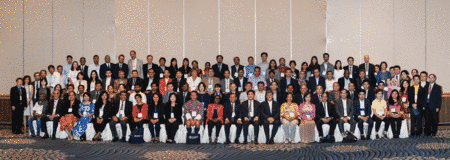Asia Regional Policy Dialogue
The Asia Incentives for Ecosystem Services (IES) Regional Dialogue was held in Bangkok, Thailand on 17-19 July 2019 as part of the two-day Regional Consultative Dialogue event on Biodiversity Mainstreaming across Agricultural Sectors organized by FAO-Regional Office for Asia and the Pacific.
The FAO Biodiversity Mainstreaming Platform was created during the 13th Conference of Parties (COP) to the Convention on Biological Diversity (CBD) after Parties called for the mainstreaming of biodiversity across all agricultural sectors and adopted the Cancun Declaration on Mainstreaming the Conservation and Sustainable Use of Biodiversity for Well-Being.

The Biodiversity Mainstreaming Platform has enabled FAO to convene Multi-Stakeholder Dialogues across regions of the world to develop regional priorities and concrete actions to reverse the fast moving biodiversity degrading trends that have been predicted to impact across sectors. It also builds on IES work to respond to CBD Decision XIII/3 Biodiversity Mainstreaming across Agricultural Sectors paragraph 32.
In particular, “to use an appropriate mix of regulatory and incentive measures aligned with national biodiversity objectives, including the elimination, phasing out and reform of incentives harmful to biodiversity…” And “to encourage public and private sources of finance to be channeled into practices that improve the sustainability of production while reducing biodiversity loss, and to promote and support the restoration of ecosystems that provide essential services in a way that provides for the needs of indigenous peoples and local communities, does not cause harm to other ecosystems, and consistent with national legislation and international obligations; [...]”
The Regional Consultative Dialogue in Bangkok was the first of these Multi-Stakeholder Dialogues. It brought together 150 participants across agriculture and environment sectors, regional integration bodies, farmers organizations, private sector, policy and research institutions and different UN agencies. The programme included a high level segment and four parallel thematic working groups in which participants discussed biodiversity mainstreaming through the lenses of global governance, national policies and legislation, incentives and investments, and value chains. This highlights the significance of the role of incentives and the importance of cross-sectoral governance, and how the IES approach can be used to support this platform.

Discussions in plenary and nine working groups provided a basis to enable cross-sectoral work and engagement across levels, from national to local communities. Discussions included challenges and gaps to be address included acceleration, policies and incentives for mainstreaming biodiversity-friendly agricultural practices in sustainable food systems, and the scaling up of good practices to enable wider impact to transform landscapes and reverse biodiversity loss.
Key discussions in the working groups included:
- How to facilitate planning and investment across agriculture and the environment?
- Can programmes assisting rural producers in improving productivity and income be made conditional on the adoption on environmental safeguards? What are the perverse incentives?
- How to achieve and identify ‘triple benefits’ from interventions to address climate change, biodiversity and land degradation?
- How can we best coordinate activities across the three “Rio Conventions”?
Next steps
Next steps
Priorities and next to further the Biodiversity Mainstreaming Platform reflect the IES approach to map landscape level incentive needs, identify finance from public, private and civil society initiatives and improved coordination across sectors to pair incentives for conservation with those for improved production.
Key next steps included:
- To increase cross-sectoral coordination at regional and national scales, including NBSAPS, etc.,
- To work at landscape level, including cross-sectoral and multi-stakeholder application to achieve landscape scale management. Design policies across the landscape to include protected area and secondary or planted forest as wildlife does not recognize administrative boundaries is essential.
- Market incentives for agrobiodiversity-friendly practices: New market opportunities or value addition schemes should be developed to encourage biodiversity preservation (e.g. Geographic Indications, Organic foods premium, strengthened linkage between producers and customers, E-Commercial agriculture)
- The large financial support in agriculture (including subsidies) that is potentially harmful for the environment is a result of the incomplete picture of the true costs and benefits in agriculture and food systems
- To increase positive impacts, conservation measures should be paired with alternative income generating activities and livelihood, and we must incentivize farmers in the transition to sustainable practices. One way is combining support for conservation with productivity investments can create convergence at farm level, but this requires different packages of incentives, for different types of farmers.-
- To develop enabling conditions to support this mainstreaming approach and scale up.
